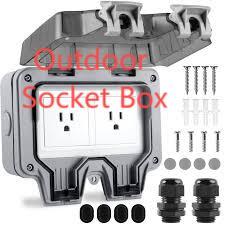Electrical Outdoor Box Factory Engineering From Nante For Thermal And Ingress Control

In modern exterior installations the choice of a properly rated Outdoor Socket Box can determine system longevity and safety, and selecting the right enclosure early prevents costly rework and field failures. Many installers learn too late that a well-specified Outdoor Socket Box reduces moisture ingress, simplifies wiring, and protects equipment from UV, salt spray, and mechanical damage.
Assessing site conditions
A successful specification begins with a careful site survey. Identify exposure to direct rain, splash zones, sun, salt-laden air, chemical mists, or washdown procedures — each condition changes the required protection level. Consider expected mechanical impacts and vandal risk in public spaces, and whether the box will be mounted on wood, concrete, metal, or composite panels. Ambient temperature ranges and thermal cycling also influence material selection and gasket performance.
Materials and corrosion resistance
Material choice drives lifespan. Marine-grade stainless steel resists chloride corrosion for coastal installations but increases weight and cost. Powder-coated aluminum balances corrosion resistance with lower weight, while UV-stable polymers and glass-reinforced polyester offer non-conductive, impact-resistant alternatives. Pay attention to fastener metallurgy and plating on internal terminals to avoid galvanic corrosion. Where chemical exposure is expected, choose finishes and sealants that resist specific contaminants rather than relying on generic coatings.
Sealing strategies and ingress protection
Gasket geometry, compression method, and cable gland selection determine how well a box keeps out water and dust. Replaceable gasket channels are valuable for long-term maintenance. Verify ingress protection ratings with documented test results rather than marketing claims — IP66 or IP67 are common targets for wet outdoor locations, but splash-prone or buried installations may require higher protection. Ensure gland plates and cable entries maintain consistent compression around different cable diameters by using correct-sized glands and strain relief.
Nante product range and modular options
Modular designs simplify installation and reduce field modification, because pre-configured mounting plates and removable gland sections let contractors adapt layouts without breaking seals. Look for enclosures that accept surge protection modules, fused outlets, or mixed power and data inserts so a single location can serve multiple functions. Factory-applied seals and bench testing are advantages because they reduce on-site troubleshooting and verify performance before shipment.
Installation practices that preserve ratings
Even the best enclosure will fail if installed poorly. Use the correct anchors for the substrate and ensure mounting flanges do not compress gaskets unevenly. Route cables to avoid sharp bends and stress at glands; apply recommended torque to terminal screws to maintain low resistance joints. If conduit is used, seal entry points and verify that thermal expansion is accounted for in long runs. After commissioning, perform a visual check and a simple water spray test where feasible to confirm seals before handing over to operations.
Maintenance, inspection, and lifecycle planning
Plan periodic inspections for gasket compression, fastener security, and terminal discoloration that can indicate overheating. Keep spare gaskets and common inserts in inventory to allow quick repairs. Thermal imaging during scheduled maintenance can reveal hot spots before they cause damage. Document installation details — gland sizes, torque values, and mounting heights — so replacements match original performance expectations. Consider supplier-provided spare kits to reduce downtime.
Smart integrations and future-proofing
Designing for future upgrades increases long-term value. Reserve space and power for sensors, surge arrestors, or remote monitoring modules. Monitoring door status, humidity, and internal temperature can enable predictive maintenance and reduce unplanned outages. Modular insert families that support both power and communications simplify later retrofits and avoid cutting new access points into an existing weatherproof assembly.
Final recommendations and resource
Choose an enclosure family that matches your site environment, provides serviceable seals, and supports modular expansion. Early collaboration between design engineers, installers, and the enclosure supplier reduces surprises and ensures long-term reliability. For detailed product options, test reports, and installation guidance, visit www.nante.com/product/
- Art
- Causes
- Crafts
- Dance
- Drinks
- Film
- Fitness
- Food
- Παιχνίδια
- Gardening
- Health
- Κεντρική Σελίδα
- Literature
- Music
- Networking
- άλλο
- Party
- Religion
- Shopping
- Sports
- Theater
- Wellness
